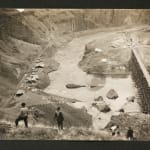B.B. Bakowski; Fred L. Blair; and others
Album Showing Construction of the Oregon Trunk Railway Amidst the Deschutes Railroad War, c. 1909
Silver prints (125)
Approximately 100 3 1/2 x 5 1/2 inches or smaller; the rest 5 x 7 inches
Some with captions and credits in negative.
Some with captions and credits in negative.
Further images
-
(View a larger image of thumbnail 1
)

-
(View a larger image of thumbnail 2
)

-
(View a larger image of thumbnail 3
)

-
(View a larger image of thumbnail 4
)

-
(View a larger image of thumbnail 5
)

-
(View a larger image of thumbnail 6
)

-
(View a larger image of thumbnail 7
)

-
(View a larger image of thumbnail 8
)

A tidy, early 20th-century photo album documenting construction of the Oregon Trunk Railway Line over the Deschutes River in Wasco County, Oregon. Present are numerous real photo postcards by B.B....
A tidy, early 20th-century photo album documenting construction of the Oregon Trunk Railway Line over the Deschutes River in Wasco County, Oregon. Present are numerous real photo postcards by B.B. Bakowski, noted Oregon photographer who disappeared during a blizzard at Crater Lake, as well as a number of beautiful, larger photos by Frank L. Blair.
The album begins with a handful of group shots, including one showing a group of men posed outside the offices of the Porter Brothers, the firm contracted by John F. Stevens, president of the Oregon Trunk Railway, to construct the Trunk Line on the West side of the river. It continues with several real photo postcards created by B.B. Bakowski, including shots of “coyote blasting,” a method of rock excavation that involves detonating explosives in tunnels drilled into a rock face, as well as some other small-format images of the crew. The last section of the album contains larger-format photographs by Frank L. Blair, including a dramatic view of crewmembers standing over Tunnel Hill, a shot of the Sherar Hotel, and other compelling photos.
In 1909, a heated battle over Oregon’s natural resources began with the construction of two separate railroads, the winner of which would be the first of its kind to reach central Oregon. The ordeal was known as The Deschutes Railroad War, and it became an outlet for the personal feud between James J. Hill, owner of the Oregon Trunk Railway Line, and Edward Harrimon, railway tycoons who were motivated by access to central Oregon’s yellow pine timber and a deep disdain of each other.
An absurd competition commenced, in which the two companies built parallel tracks on either side of the Deschutes River at the same time, each trying to finish construction before the other. To slow down the other company’s efforts, creative methods of sabotage were taken by the construction teams. These included taking potshots at the other camp, raiding the opposing teams supplies, and blowing up reserves of black powder to delay construction. According to Leon Speroff, author of “The Deschutes Railroad War”, “The blame for the infighting lays mostly with the supervisors who created an atmosphere of conflict.”. Though probably not intended to actually harm workers, the delay tactics and infighting between the construction camps eventually escalated so much that the local sheriff got involved, and the battle for the railway was taken to the courts.
In the end, it was the death of Harriman in late 1909 and the willingness of his successor Robert Lovett to compromise and work with Hill that brought an end to the conflict. The two railway efforts were eventually merged into one, with both companies sharing the maintenance costs.
The album begins with a handful of group shots, including one showing a group of men posed outside the offices of the Porter Brothers, the firm contracted by John F. Stevens, president of the Oregon Trunk Railway, to construct the Trunk Line on the West side of the river. It continues with several real photo postcards created by B.B. Bakowski, including shots of “coyote blasting,” a method of rock excavation that involves detonating explosives in tunnels drilled into a rock face, as well as some other small-format images of the crew. The last section of the album contains larger-format photographs by Frank L. Blair, including a dramatic view of crewmembers standing over Tunnel Hill, a shot of the Sherar Hotel, and other compelling photos.
In 1909, a heated battle over Oregon’s natural resources began with the construction of two separate railroads, the winner of which would be the first of its kind to reach central Oregon. The ordeal was known as The Deschutes Railroad War, and it became an outlet for the personal feud between James J. Hill, owner of the Oregon Trunk Railway Line, and Edward Harrimon, railway tycoons who were motivated by access to central Oregon’s yellow pine timber and a deep disdain of each other.
An absurd competition commenced, in which the two companies built parallel tracks on either side of the Deschutes River at the same time, each trying to finish construction before the other. To slow down the other company’s efforts, creative methods of sabotage were taken by the construction teams. These included taking potshots at the other camp, raiding the opposing teams supplies, and blowing up reserves of black powder to delay construction. According to Leon Speroff, author of “The Deschutes Railroad War”, “The blame for the infighting lays mostly with the supervisors who created an atmosphere of conflict.”. Though probably not intended to actually harm workers, the delay tactics and infighting between the construction camps eventually escalated so much that the local sheriff got involved, and the battle for the railway was taken to the courts.
In the end, it was the death of Harriman in late 1909 and the willingness of his successor Robert Lovett to compromise and work with Hill that brought an end to the conflict. The two railway efforts were eventually merged into one, with both companies sharing the maintenance costs.







